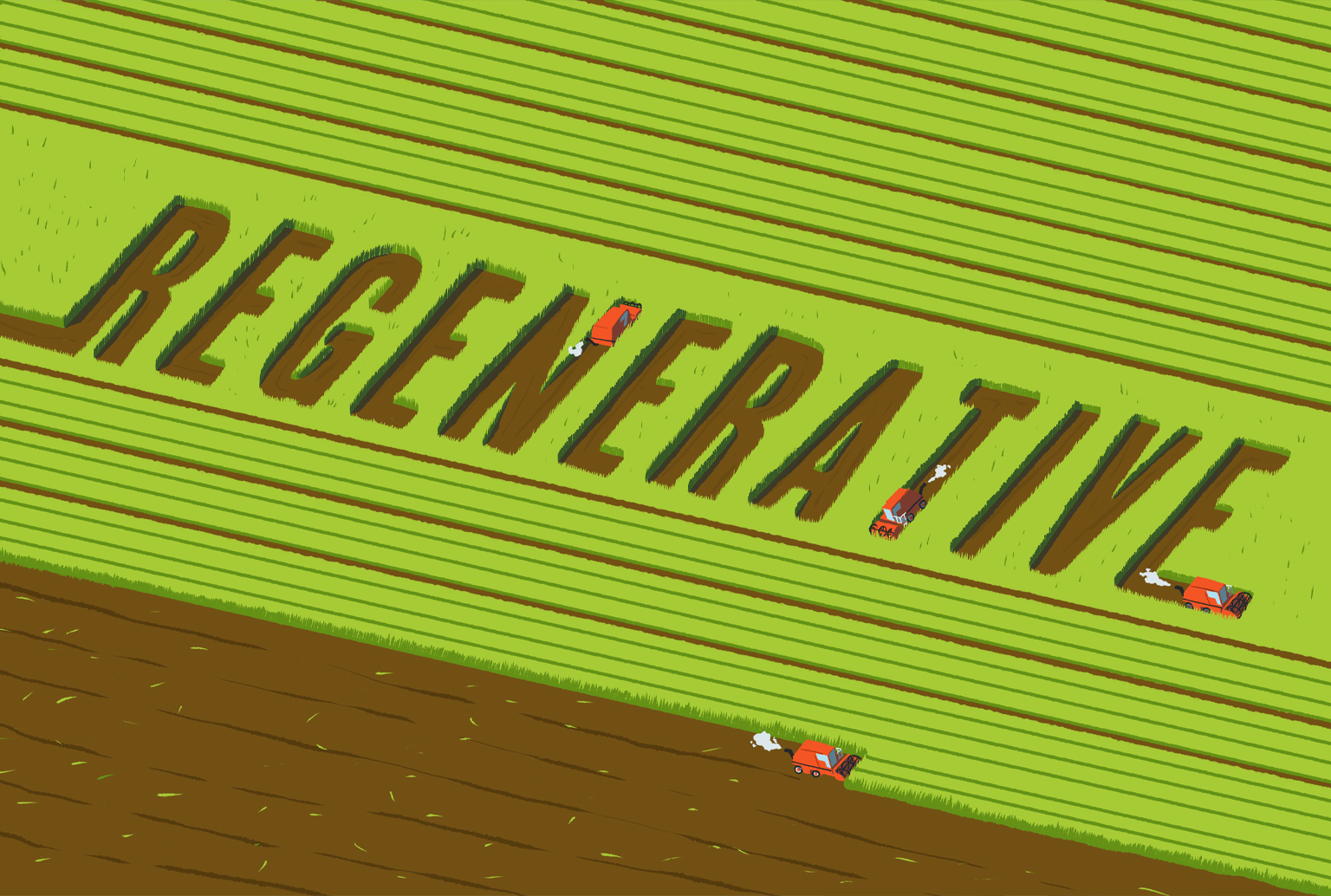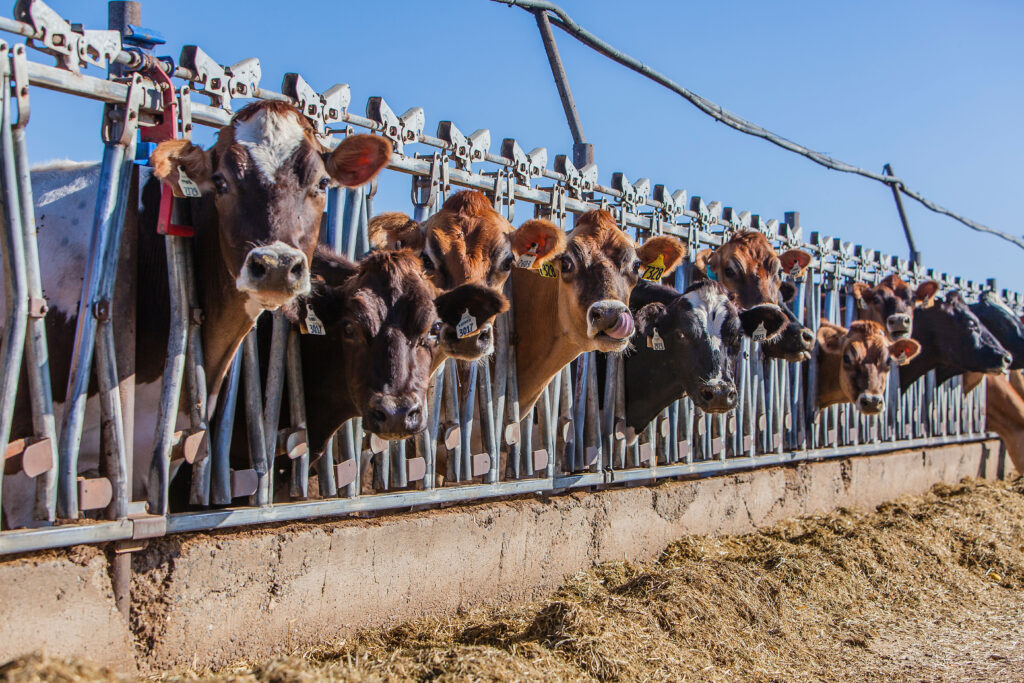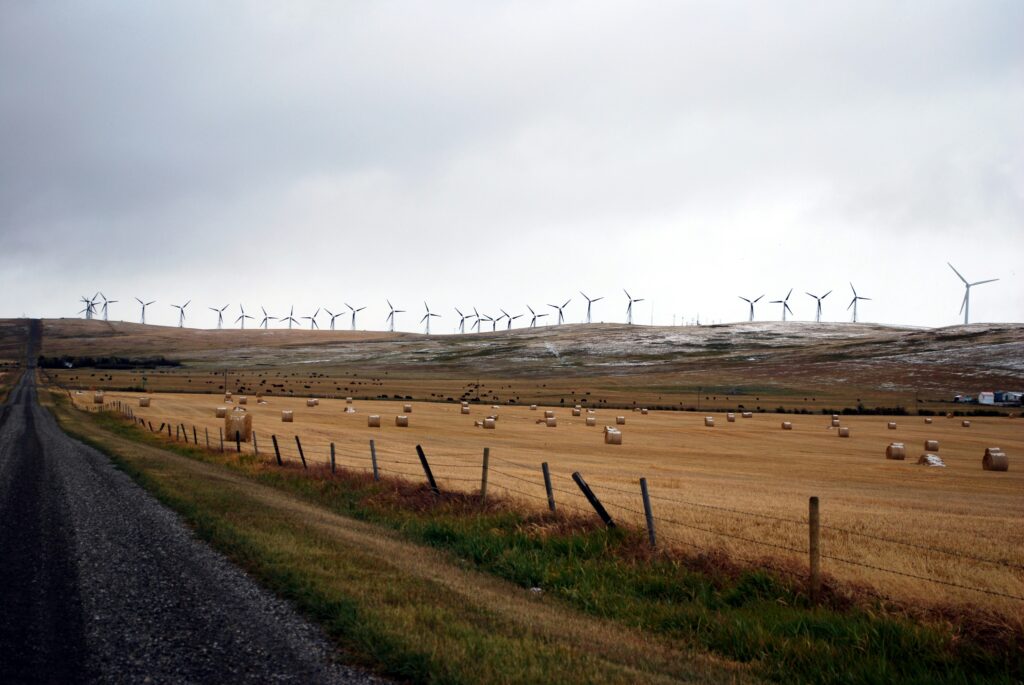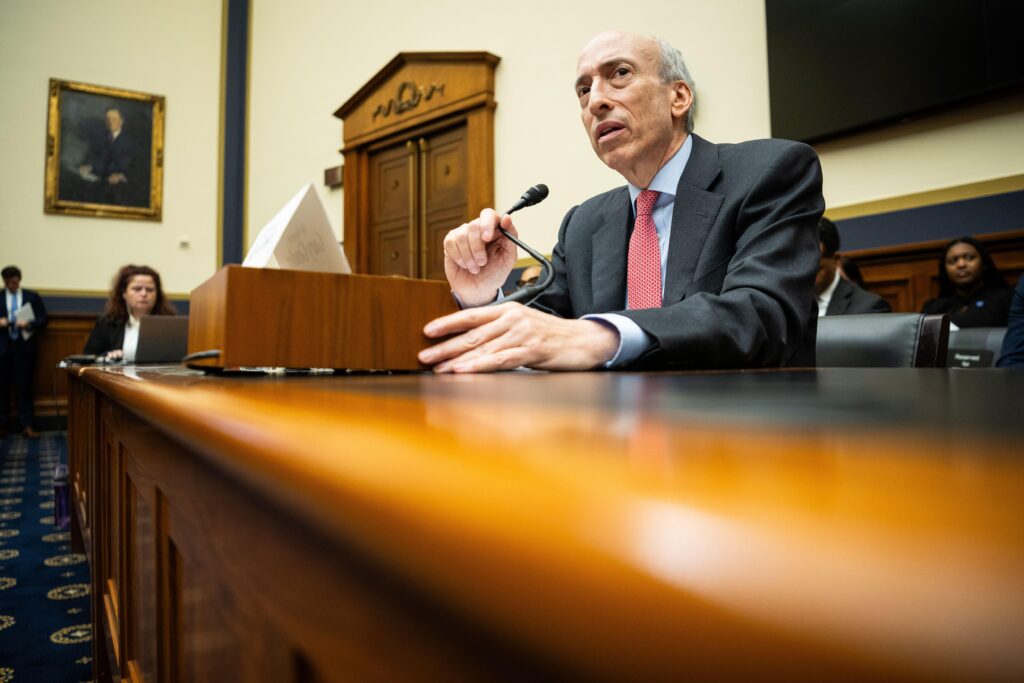Agriculture, which is responsible for over one third of the world’s emissions, will be under the spotlight at the upcoming COP28 global climate summit in Dubai.
In the wake of blazing heat, rising food insecurity and devastating floods, COP28 leaders have released a four-point “food and agriculture” agenda for the conference, which will call for governments to work with industry to find new solutions.
As some of the biggest companies – in particular meat and dairy firms – grow more concerned about their climate-villain images, they are turning to greenwashing techniques: well-known tactics deployed by oil and gas industries to shift the debate away from meaningful action. Often valid concepts in and of themselves, the problem lies in how they are touted as enviro-friendly actions while companies fail to cut their contribution to global heating.
The agriculture industry has a lot to be worried about. Meat emits around a third of global emissions of methane, and action to cut this greenhouse gas has been identified by the UN and world leaders as the quickest route to slowing global heating. Farming also relies on synthetic fertilisers that are both fossil-fuel-based and emit greenhouse gases, and drives deforestation.
Major food and farming corporations will be seeking to steer conversations in Dubai via an influential coalition: the AIM for Climate (Aim4C) initiative. Spearheaded by the US and United Arab Emirates (UAE), Aim4C will be showcasing $13 billion-worth of joint projects (or “innovation sprints”) which feature many high-tech “climate-smart” solutions that are favoured by industry, and include some dubious technologies unproven at scale.
The phrases laid out below will also be in the back pockets of lobbyists, who doubled in number year on year in 2022 as an analysis by DeSmog revealed, and are expected to show up in force in 2023.
As with the last summit, the risk continues to be that greenwashing leaves governments with “a vision that tinkers around the edges,”rather than a transformative one that creates food systems that are resilient and restore ecosystems,” as Shefali Sharma, director of the Institute for Agriculture and Trade Policy (IATP), warned at COP27.
With that in mind, here are some essential greenwashing terms to watch out for ahead of Dubai’s summit from November 30 until December 12, 2023.
Regenerative Agriculture
Often accompanied with: carbon storage, no till, crop rotation
With host country the UAE spearheading a new “Regenerative Landscapes” project in close partnership with the likes of Pepsico, Nestlé and fertilizer giant Yara, the term “regenerative agriculture” is likely to be a hot topic at COP28.
In recent years, the biggest agricultural polluters and food corporations have embraced this term, which refers to a wide range of farming techniques that improve the environment. No-till and organic farming fall under the banner of regenerative agriculture, as well as the use of cover crops. All these methods work to improve the soil, reduce air and water pollution, cut emissions, and boost biodiversity.
However, a 2020 assessment of regenerative agriculture from the World Resources Institute (WRI) found that while good for the environment, it has “limited potential” to mitigate climate change. The science is also uncertain around soil’s ability to store carbon, which can be easily undone through erosion, or changes in land use or the weather.
But this doesn’t stop many companies from citing these approaches in net zero plans. In recent years, many major agricultural corporations across the farming sector have employed the term – from meat and dairy producers and suppliers including JBS, and Danone, to grain companies such as Archer Midland Daniels and agrochemicals producers like Bayer and Syngenta.
These big ag entities often link regenerative agriculture to carbon storage in the soil. The agrochemical industry says it’s climate friendly, for example, because pesticides can reduce the need for tilling (which releases carbon when farmers plough the soil to kill weeds, among others things).
The meat and dairy industries emphasize how grazing livestock play an important function in regenerating and preserving grasslands, which can act as an important global carbon sink. The term is also trotted out by fast food company McDonalds – which, as one of the world’s largest suppliers of beef, emits more greenhouse gases than American Airlines.
Several Aim4C “innovation sprints” are based on regenerative agriculture, including one on “sustainable beef”. But with emissions from beef production globally roughly equal to those of the entire nation of India, science thus far points to a shift in diets as the one surefire way to cut emissions.
Nature-based Solutions
Often associated with: trees, offsets, soil sequestration, conservation, nature-positive.
At COP28 this year you’ll be sure to hear this term, which big food and farming have recently rallied around.
Nature-based solutions refer to anything that involves the use of the natural world to absorb carbon and remove harmful emissions from the atmosphere. This can mean restoring or protecting areas such as croplands, grasslands, wetlands and forests in the interests of nature or climate protection.
Food and farming companies have a particular interest in this. As potential providers and users of “carbon credits”, they stand to make money from selling products that allow them and other polluting industries to “offset” emissions elsewhere in their operations.
“Nature-based solutions” is one of the only phrases linked to agriculture to be mentioned in the COP cover text. It was included for the first time in 2022, when food also got its first ever mention. This year, the term will likely be part of discussions related to negotiations around Article 6.4 of the Paris Agreement, which would provide the structure for a global carbon credit market.
While the term lacks a widely agreed definition when used to discuss climate change, advocates of nature-based solutions say when managed well, these projects work, absorbing carbon, protecting ecosystems and wildlife, and creating jobs. But campaigners say the vagueness of the term leaves it ripe for corporate greenwashing.
Offsetting schemes, for one, have been criticised as “mostly junk” and a “free pass to pollute” for carbon intensive companies. Oil giant Shell, for example, raised eyebrows by pledging to plant trees over a land area the size of Brazil.
Carbon credit projects have been linked to human rights abuses and land grabs. And questions have arisen over their effectiveness and permanence when a wildfire can instantly undo carbon removals from trees or peatlands.
The Supervisory Body of the United Nations Climate Change board is currently developing specific guidance on what “nature-based solutions” – tree cover, forest management or soil sequestration etc – should be counted as a carbon credit under Article 6.4.
Food and farming companies have a lot to gain from a broad definition in the Supervisory Body’s rules, which will be voted on at COP28 by member countries, and many firms will be hoping to see nature-based solutions widely embraced at this year’s summit.
Climate Neutrality
Often shows up with: climate-friendly beef, GWP*
Blink and you’d miss it. We are so used to carbon neutrality and ‘net zero’ that this meat and dairy adaptation can slip by unnoticed.
With the term climate neutrality comes a contentious new way of calculating the emissions of methane, called the “global warming potential star”, or GWP*.
The metric is a new way to measure the short-lived warming impact of methane, which traps heat about 80 times more effectively than carbon dioxide but loses potency over time, beginning to break down in the atmosphere after 12 years.
While the science is accurate, Bloomberg Green has reported how GWP* – which reflects changes in the amount of methane in the atmosphere – has the effect of penalising new or growing sources of the gas.
Director of research at the Grantham Institute and IPCC author Joeri Rogelj has warned that the metric can be applied in ways that have “unethical consequences”. He told investigative outlet Unearthed that GWP* could be used to give credit to high, steady emitters for polluting slightly less and put the Global South where emissions are low but increasing, at a disadvantage.
Sure enough, big beef and lamb producers in the Global North have jumped on this metric to get off the hook for their outsized climate contributions (and have lobbied the leading UN climate science body the IPCC to adopt it).
Much of this work references the science of U.S-based Professor Frank Mitloehner, who has used GWP* to claim that the U.S meat and dairy sector can become “climate neutral” by the late 2040s by reducing emissions only two percent a year.
Alongside GWP*, the meat and dairy industry promotes other technologies as a route to less emissions. These include feed additives to reduce methane in cow burps and “biogas digesters” to capture and burn methane from lagoons of liquid manure. Both have drawn criticism for being respectively unproven at scale, and polluting.
Mitloehner, who defends GWP* to its critics, gave a talk on the benefits of animal agriculture at COP27 last year at the “Home of Sustainable Agriculture of the Americas” pavilion, which was sponsored by several major beef industry groups, and hosted by the industry-friendly Inter-American Institute for Cooperation on Agriculture.
His department at University of California, Davis, is funded and was founded by American Feed Industry Association, which has had delegates on the ground at COPs in recent years and is one of many meat and dairy trade groups partnering with Aim4C.
Other powerful advocates of GWP* include industry groups such as Beef + Lamb New Zealand, which is partnering with Aim4C at this year’s COP28 and has had representatives lobbying at past COPs.
The “beef industry’s fuzzy methane math” (as Bloomberg Green calls it) coincides with the realisation by scientists and world leaders that cutting short-lived methane offers the quickest route to keeping the Earth’s temperatures below tipping points that might lead to runaway global heating.
In 2021, awareness of methane’s critical importance prompted the Global Methane Pledge, which committed to reduce methane emissions 30 percent by 2030, but made no concrete demands on agriculture.
At COP28, the pressure is still on for countries to deliver action on reducing methane emissions. A methane pledge summit is expected, but agriculture is still seen as a side issue, with a focus on voluntary action by the industry.
Emissions Intensity
Often pairs with: efficiency.
Like oil and gas companies, agriculture’s biggest polluters caught on to the need to talk about their emissions reductions, too. But this often comes with a significant catch.
While major meat, dairy, and agrochemical companies often publicise their efforts to cut greenhouse gases, this frequently comes with a caveat: The fine print shows these are “emissions intensity” reductions, producing fewer emissions per ton or per kilo, rather than “absolute emissions” targets, which would cut emissions overall.
European meat and dairy giants Arla and Danish Crown use these “emissions intensity” targets. Prominent industry initiatives at climate summits also use them.
The Pathways to Dairy Net Zero initiative (P2DNZ), launched at Glasgow’s COP26 and which runs an AIM for Climate innovation sprint, is among many initiatives pushing to have action on emissions framed in terms of intensity only.
P2DNZ, which is well-connected to dairy producers, distributors, and scientists, describes itself as a “growing movement” dedicated to reducing dairy’s greenhouse gas (GHG) emissions over the next 30 years. It has support from powerful leaders, including U.S Secretary of Agriculture, Tom Vilsack.
The relentless focus on intensity aims to keep the idea of cutting production – or targets – off the menu. These include suggestions such as those of the 2019 EAT-Lancet Commission into food, planet and health, which prescribed wealthy countries make deep cuts to meat and dairy consumption.
Efficiency
Often shows up with: “emissions intensity”, “doing more with less”, climate-smart agriculture
Some of agriculture’s largest emitters are also pushing for “efficiency”, especially the pesticide and fertiliser industries.
The pesticide industry had a large presence at the last summit, with 27 delegates linked to the world’s top five pesticide producers – a greater number than delegates from entire delegations of some countries. We can expect a similar turnout at this year’s COP, too.
While the harmful impacts of agrochemicals on human and ecosystem health are well understood, their links to climate change have been historically overlooked. But pressure is starting to grow on fertiliser companies in particular over their climate impacts.
It’s a little known fact that nearly all fertilisers and pesticides are derived from fossil fuels and emit greenhouse gases throughout their manufacturing and use. A study in August 2022 found that the global climate impact of nitrogen fertiliser – which is made from natural gas – exceeds that of commercial aviation, contributing roughly two percent of all global greenhouse gas emissions.
Fertiliser also contributes to declining soil health, including the soil’s ability to store carbon.
But rather than accept that a reduction or major rethink is needed, bodies such as the International Fertilizer Association – which represents all major producers – insist that efficiency will allow its business to continue and grow, as it expands into new markets.
Alongside, the fertiliser industry is also billing its businesses as “clean energy companies of the future”, with a promise to capture and store the CO2 from its operations and manufacture hydrogen, which is promoted as a substitute fuel for conventional fossil fuels.
Pesticide companies – whose successful lobbying has succeeded in delaying EU farming reforms aimed at protecting its decimated populations of bees, birds and butterflies – also promote efficiency. Often this will focus on “precision” technologies, selling farmers new tools such as artificial intelligence, drones and remote sensors.
While its proponents say improved efficiency will lead to a cut back in agrochemical use, recent studies have shown that this argument proved untrue in the case of genetically modified (GM) crops, which use the same amount of pesticides as non-GM. The industry habit of dumping vast quantities of pesticides banned in the EU on low-income countries does not bode well for “efficiency” savings either.
But this industry narrative has some powerful backers. Last year, U.S. agriculture chief Tom Vilsack announced the U.S. Department of Agriculture (USDA) would contribute $25 million to new fertiliser efficiency initiatives, which include an Aim4C innovation sprint. Others giving public money include the government of Norway, which owns a stake in Yara, one of the largest fertiliser companies in the world.
Yara, which sponsored a COP pavilion last year and sent three delegates, this year will be joined by other fertiliser producers, including OCP Group and UPL, which are listed among the UAE’s partners as part of COP28’s Pillar 2 of the “COP Food Systems Working Group”.
Civil society groups’ concern is that these influential companies are crowding out the findings of research that makes the case for reducing damaging inputs in favour of “natural” fertilisers, and holistic, remodelled climate-friendly farming techniques.
Sustainable Intensification
Often used in conjunction with: precision agriculture, feeding the world, global markets
You can expect the battle over the future of the food system, and between the “sustainable intensification” and “agroecological” visions of farming, to be waged fiercely this year at COP28.
Major agricultural companies – with high carbon footprints – institutes and foundations advocate for “sustainable intensification”, which is underpinned by the idea that industrial farming can continue to grow – indeed must grow to feed an increasing world population – but can do so while causing less damage, producing “more with less”.
Built on top of the “efficiency” and “intensity” arguments seen above, the concept brings in a new line of justification for industrial farming. It holds that this approach will also tackle deep-rooted social issues – such as global hunger, food security and poverty.
The contrasting vision is offered by agroecology. A collection of green farming techniques and principles, it also advocates for increased yields but achieved through cutting harmful inputs, a wholesale shift to nature-friendly methods of farming – and rebalancing power towards smallholders and food workers, along with proposing a move to diversified, healthier diets for all.
Campaigners accuse proponents of industrial farming of co-opting social justice arguments to justify their business models. The UN-linked Committee on World Food Security also offers a counterpoint to the notion that food scarcity causes hunger and malnutrition, pointing instead to problems with access, distribution and power.
Proponents of agroecology point out that more than a third of all crops grown go to animal feed, which support meat-rich diets in middle and high-income countries, and around one third of the food produced for human consumption goes to waste.
Their conclusion: sustainable intensification offers tweaks to how food is made at a time when radical new visions are needed for different and deeper changes.
Otherwise, they say, large companies in a highly concentrated industry will consolidate market positions, sell more chemical inputs and keep us locked into a polluting, destructive model of industrial food production that continues to cross multiple planetary boundaries.
A deeper analysis of our food systems is slowly edging its way into the UN climate process. In July, the Secretary General of the United Nations Antonio Guterres called the current system “broken.”
The UAE’s Climate Minister and food systems lead Mariam Almheiri is calling for “national food systems and agricultural policies” to be aligned with Nationally Determined Contributions (NDCs) for the first time.
But while Almheiri has called on “a diversity of actors” to find solutions it’s unclear where the groups advocating for agroecology (which is mentioned once in Aim4C’s 51 innovation sprints) will find traction or finance for their vision of agriculture.
DeSmog is tracking the influence and arguments of big agriculture on climate as part of our COP28 series.
Stay with the story by signing up to DeSmog’s weekly UK Newsletter.
Subscribe to our newsletter
Stay up to date with DeSmog news and alerts







